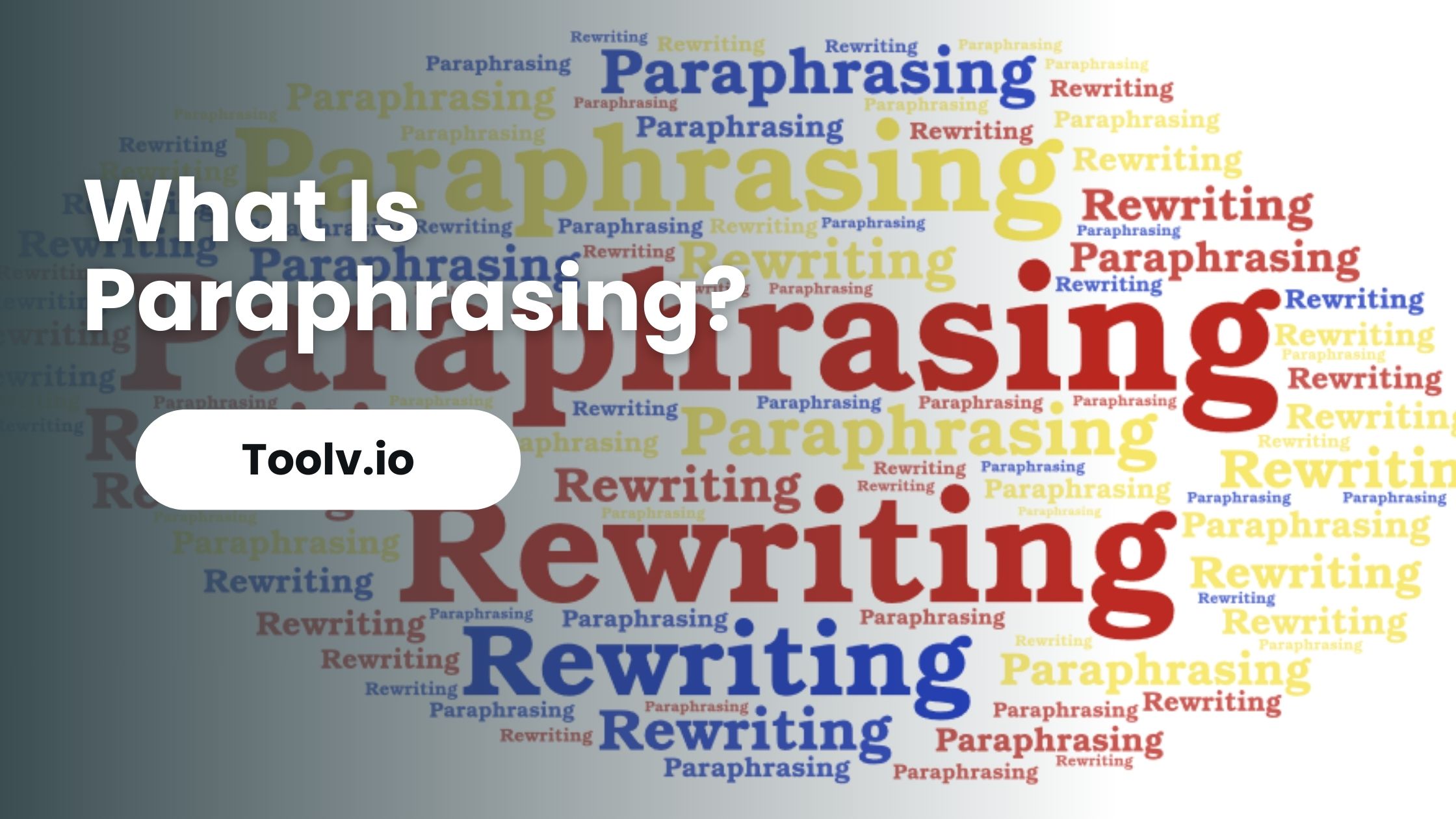What is a Paraphrase Example?

A paraphrased example is when you take a sentence or a piece of writing and rewrite it in your own words. This is different from quoting directly because you’re not copying the exact words. Instead, you’re expressing the same ideas in a new way.
In this article, we will discuss how to write effective paraphrases, why they are important, and the differences between paraphrasing and summary. You’ll learn how to use your own words to convey the same message as the original text without losing the original meaning.
What is a Paraphrase Example?
Paraphrasing means saying the same thing in different words. Imagine you read a sentence and then explain it to someone using your own words. That’s paraphrasing.
For example, if the original sentence is “The cat sat on the mat,” a paraphrase might be “Sat on the mat was the cat..” Both sentences mean the same thing, but the words are different.
This method is often used to avoid copying someone’s work directly, known as plagiarism. It’s important in writing, especially when you want to use someone’s ideas without copying their exact words.
Paraphrasing shows that you understand what you read and can explain it in your own way.
How Do You Write a Good Paraphrase?
- Understand the Original Text: First, read and understand the original text thoroughly. You can’t paraphrase something you don’t fully grasp. If it’s complex, break it down into smaller parts and understand each part.
- Use Your Own Words: Rewrite the text using your vocabulary. Avoid using the same words or phrases from the original, except for technical terms or specific names that can’t be changed.
- Maintain the Original Meaning: Ensure your paraphrase reflects the same idea or information as the original. It should be a restatement, not a reinterpretation or summary.
- Change the Sentence Structure: Besides changing words, also alter the sentence structure. For example, if the original sentence is passive, consider making your paraphrase active or combine two short sentences from the original into one longer sentence in your paraphrase.
- Compare with the Original: After writing your paraphrase, compare it with the original text to ensure you’ve captured the essence without copying the wording. It should be different in phrasing but similar in meaning.
- Cite the Source: Even when you paraphrase, it’s important to give credit to the original author. This avoids plagiarism. Include a citation according to the required style guide (APA, MLA, Chicago, etc.).
What Are the 3 Ways to Paraphrase a Sentence?
Synonym Replacement
This involves swapping words in the original sentence with their synonyms while keeping the meaning the same.
For example, if the original sentence is “The quick brown fox jumps over the lazy dog,” a paraphrased version could be “The fast brown fox leaps over the sluggish dog.” Here, ‘quick’ is replaced with ‘fast’, ‘jumps’ with ‘leaps’, and ‘lazy’ with ‘sluggish’.
Changing Sentence Structure
You can also change the structure of the sentence. This might mean turning a passive sentence into an active one, breaking a long sentence into two shorter ones, or combining short sentences into a longer, compound sentence.
For instance, “The cake was eaten by the boy” (passive) can be paraphrased as “The boy ate the cake” (active).
Combining and Dividing Information
Sometimes, paraphrasing involves combining information from multiple sentences into one or dividing information from one long sentence into multiple shorter sentences.
For example, “The sunset. The sky turned orange.” can be paraphrased as “As the sun set, the sky adopted an orange hue.“

What Is a Good Sentence for the Word Paraphrase?
A paraphrase is when you say something that someone else has said or written, but you use different words. It’s like explaining someone else’s ideas in your way.
For example, if your friend tells a story, you might tell the same story to someone else, but you use your own words. This is a good way to show you understand what was said or written.
When you paraphrase, it’s important not to change the main idea. The goal is to keep the original meaning but to express it in a new way. It’s like taking a recipe and using different ingredients to make the same dish. It still tastes similar, but it’s a bit different.
What Is an Example of a Paraphrasing Conversation?
Original Conversation:
- Person A: “I’m really tired today because I stayed up late working on my project.”
- Person B: “That sounds tough. Make sure you get some rest tonight.”
Paraphrased Conversation:
- Person A: “I feel exhausted because I was up until late finishing my project.”
- Person B: “That seems hard. Don’t forget to rest well this evening.”
In the paraphrased version, the main ideas from the original conversation are kept the same. Person A talks about being tired due to working late, and Person B responds with empathy and a suggestion for rest.
However, the specific words and phrases are changed to convey the same ideas differently.
What Not to Do When Paraphrasing?
- Don’t Copy the Original Text Exactly: Avoid using the same phrases or sentences from the source material.
- Don’t Change the Meaning: Ensure that the paraphrased version doesn’t alter the original intent or message.
- Don’t Forget to Cite the Source: Even when paraphrasing, it’s important to give credit to the original author.
- Don’t Use Too Many Similar Words: Replace words with synonyms where possible, rather than just changing the sentence structure.
- Don’t Overlook the Style and Tone: Try to maintain the style and tone of the original text, especially if it’s significant to the meaning.
- Don’t Ignore the Context: Make sure the paraphrased text fits well within the context of your overall content or argument.
What Is the Difference Between Paraphrasing and Summarizing?
Purpose and Detail
Paraphrasing: The goal is to restate the original content using different words and phrasing while keeping all the original ideas and details. It’s almost the same length as the original text.
Summarizing: This involves condensing the main ideas of the text into a shorter form. A summary highlights only the key points and omits most details, resulting in a much shorter version than the original.
Usage
Paraphrasing: Used when you want to clarify or simplify the original text, or when you need to use the information differently but keep all the details and ideas.
Summarizing: Ideal for giving a brief overview or an abstract of a long piece of text, like a book or a research article, focusing only on the main arguments or findings.
Length
Paraphrasing: Usually similar in length to the original text because it aims to include all the details.
Summarizing: Significantly shorter than the original, capturing only the essence or main points.
In essence, paraphrasing is like translating the entire text into different words, while summarizing is like giving a brief report or overview of the most important points.
What Are the Three Types of Paraphrasing?
Word-Level Paraphrasing
This involves changing individual words in the original text with synonyms or similar words.
For example, changing “rapid” to “quick” or “huge” to “enormous.”
It’s the simplest form of paraphrasing and is often used to avoid repetition or to simplify vocabulary.
Sentence-Level Paraphrasing
Here, the structure of the sentences is changed, not just individual words.
This might involve changing active sentences to passive ones, rearranging the order of the information, or combining or splitting sentences.
For instance, “The cat chased the mouse” could be paraphrased as “The mouse was chased by the cat.”
Paragraph-Level Paraphrasing
This involves rewording and restructuring an entire paragraph.
The paraphrase maintains the original meaning and information but presents it in a completely different way.
It’s more complex and requires a deep understanding of the original text to ensure that the context and meaning are preserved.
Can You Paraphrase Without Citing?
Paraphrasing means explaining something in your own words. It’s like reading a story and then telling it more simply. You do this without copying the exact words.
Now, citing is when you tell where you got the information from. It’s like saying, ‘I learned this from a book or a person.’ When you paraphrase, you don’t always have to cite.
Like, if you talk about common knowledge, things everyone knows, you don’t need to say where you got it from. But if the idea or fact is special and not well-known, it’s good to cite. This shows respect for the original author’s work and avoids stealing ideas.
When Should I Paraphrase?
Paraphrasing is good when you want to use someone else’s ideas in your writing without copying them exactly. You should paraphrase to make things clear and easy for others to understand.
Use paraphrasing in essays or reports to mix your style with other ideas. It helps avoid too much direct quoting, which can make writing look lazy. Remember to still give credit to the original author.
Paraphrasing makes your work richer and shows you’ve done good research. It’s like using different colors in a painting to make it your own.
Conclusion
Paraphrasing means rewording text while keeping the original meaning. It’s useful for understanding or explaining ideas in new ways.
Toov.io is a tool that helps with this. It rewrites sentences, making them easier to read while keeping the key points.
Using tools like Toov.io can make learning and communication more effective. They help present information in different ways, aiding understanding and engagement.
For more information about how to convert text to speech, click our how to convert text to speech post. For free text to speech tools click on our free text to speech tool post.





